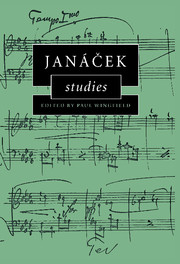Book contents
- Frontmatter
- Contents
- Preface
- 1 Expressive sources and resources in Janáček's musical language
- 2 ‘Nothing but pranks and puns’: Janáček's solo piano music
- 3 Narrative in Janáček's symphonic poems
- 4 Evasive realism: narrative construction in Dostoyevsky's and Janáček's From the House of the Dead
- 5 Direct discourse and speech melody in Janáček's operas
- 6 Kundera's eternal present and Janáček's ancient Gypsy
- 7 Janáček's folk settings and the Vixen
- 8 Janáček's operas in Australia and New Zealand: a performance history
- 9 Janáček's Moravian publishers
- 10 Janáček, musical analysis, and Debussy's ‘Jeux de vagues’
- Index
7 - Janáček's folk settings and the Vixen
Published online by Cambridge University Press: 22 September 2009
- Frontmatter
- Contents
- Preface
- 1 Expressive sources and resources in Janáček's musical language
- 2 ‘Nothing but pranks and puns’: Janáček's solo piano music
- 3 Narrative in Janáček's symphonic poems
- 4 Evasive realism: narrative construction in Dostoyevsky's and Janáček's From the House of the Dead
- 5 Direct discourse and speech melody in Janáček's operas
- 6 Kundera's eternal present and Janáček's ancient Gypsy
- 7 Janáček's folk settings and the Vixen
- 8 Janáček's operas in Australia and New Zealand: a performance history
- 9 Janáček's Moravian publishers
- 10 Janáček, musical analysis, and Debussy's ‘Jeux de vagues’
- Index
Summary
Introduction
Janáček writes in the preface to a collection of Moravian folk-song arrangements:
Dance songs are characteristic; which is why their accompaniments must not lack those typical rhythmic figures (sčasovky) that are tied to the beautiful movements of dance. In slow songs the musicians even pause on longer tones and fill them with the little tones of the tune … What a rich source of accompanimental motives! Song accompaniments are even more beautiful if at the same time they are truthful.
This statement reveals two important elements that shaped Janáček's own musical language: his profound admiration of the folk musicians' art on the one hand, and his nineteenth-century heritage on the other. His genuine love of folk-songs went back to his youth and influenced his entire philosophy of existence: ‘Folk-song! I've lived and breathed it since I was small. In folk-songs we find the whole person, body, soul, environment, everything, everything. Whoever grows up with folk-song, grows up into a whole person.’ Folk-songs touched Janáček's emotions for nostalgic reasons – as well as for the beauty of the music. To him, they encapsulated the genuine emotions and concerns of ordinary people, and they were creations equivalent in stature to those from the art-music repertory. Their apparent simplicity was necessitated only by the lack of notation, which did not affect their quality. Folk-songs also echoed Janáček's fervent nationalistic concerns.
- Type
- Chapter
- Information
- Janácek Studies , pp. 127 - 147Publisher: Cambridge University PressPrint publication year: 1999



